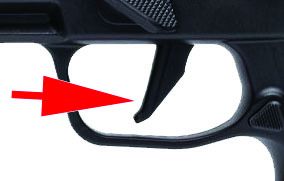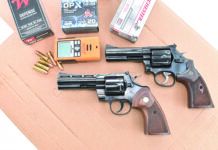Definitions
I’m new to the gun world, have taken a handgun safety class. It was recommended I read your magazine for continuing my research and education. Reading your article on the SIG Sauer P322-COMP, there are terms that I do not understand. Neither does my spouse, who has a concealed-carry permit and marksman awards.
1. Specifically, what is a trigger shoe?
2. What is a Sport takedown lever?
3. And what is a compensator?
Could you recommend a handgun definitions source for newbies like me? Your magazine is helping me along, and I especially like the clarity of the whole publication. Thanks for a helpful product. — Laura
Hey Laura: Sorry about the jargon. Let me answer your questions here:
1) The trigger shoe is the visible part of the trigger, as shown by the arrow in the drawing. Some triggers have replaceable shoes, so the shoe can be switched out to a different shape. The one pictured on the P322-COMP is straight. Others can be curved or have a safety tab in the middle of the shoe. It’s a common feature on a competition pistol to have an adjustable trigger shoe, which means the shoe can be moved forward or backward on a post or rotate left and right.
2) Not illustrated, the P322-COMP Sport’s takedown lever has a locking mechanism that prevents the shooter from unintentionally allowing the slide to disassemble, especially helpful during competition shooting. “Sport” is part of the gun’s name.
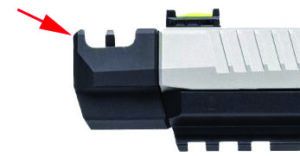
3) The compensator on this pistol is the slotted device on the front, or muzzle, of the pistol, called a “comp” for short. The holes cut in the top of the comp allow gas to exit upward out of the muzzle, which pushes the front of the pistol downward. Less muzzle rise means faster recovery shot to shot. Not that big an issue on a rimfire pistol like this one, but when you’re trying to go fast, every little tenth of a second matters.
Your letter suggests that I need to build a Gun Tests set of definitions. Wikipedia has a pretty robust list of firearms terms. On Wikipedia.org, search for “glossary of firearms terms” to find it. — Todd Woodard
38 Special Standard-Pressure Ammo
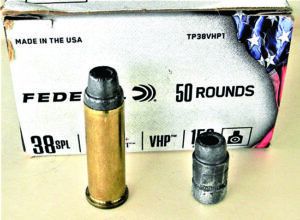
I enjoy Gun Tests greatly. Keep up the good work. My concern is about 38 Special ammo. I have read your tests, and, unfortunately, most of the rounds tested are +P. For those of us who have older guns that will not handle +P and need the plain-Jane load, would you test the standard-pressure loads so we can see what are likely at least fair defensive rounds? Some you tested are of this type, but there are many more out there that might work. Thanks. — Richard
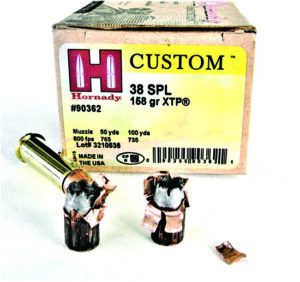
Hey Richard: We have covered a lot of standard-pressure loads over the years, and most, if not all, of those loads are still available, even if the test is quite old. To review the performance of the standard-pressure loads in detail (and differentiated from higher-pressure +P, the nomenclature for “plus pressure” rounds), look under the Ammunition tab on Gun-Tests.com. But I’ll recap a few of them here.
In the March 2022 article “Heavy 38 Special Loads Tested,” Federal Train + Protect 158-grain Lead Semi-Wadcutter Hollow Point TP38VHP1 got a B rating and penetrated 24 inches in water. At a muzzle velocity of 786 fps and generating 217 foot-pounds of muzzle energy, this shows the limitation of the standard-pressure loads generally. But as you correctly surmise, if your revolver isn’t rated for the higher-pressure loads, that doesn’t matter.
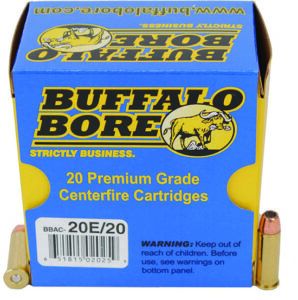
Hornady Custom 158-grain XTP JHP 90362 got a B- grade. Federal Premium Gold Medal Match 38 Special 148-grain Lead Wadcutter GM38A got a C grade.
In the July 2021 article “38 Special Loads: Federal’s Punch Is a ‘Best Buy’ Bullet,” the Buffalo Bore 125-Grain Low Flash Standard Pressure SB 20E/20 load earned an A grade and was Our Pick in that article. It’s what I use in my Smith & Wesson M642-1 Airweight 38 Special 1.85-inch-barrel carry gun, even though the gun is rated for +P ammunition. Federal Premium LE 129-Grain Hydra-Shok JHP P38HS1G is also a stout load that earned an A grade in that test.
In a November 2015 article, “Handgun Bullets: How Do They Penetrate in Home Materials?”, there were good selections from the 38 Specials. The Glaser Safety Slug in 80-grain weight offered plenty of velocity but not as much penetration. The Winchester 158-grain lead roundnose is a similar performer in a more traditional form.
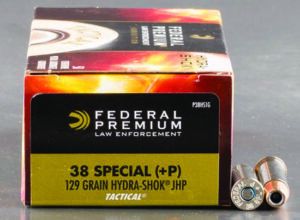
In the November 2012 article “38 Specials for Snubbie Carry: We Test Eleven Head to Head,” the Buffalo Bore Standard Pressure Short Barrel 125-grain Gold Dot HP got an A grade, as did the Hornady Critical Defense 110-grain FTX JHP 90310 and Remington UMC 125-grain JHP L38S2 load.
Perhaps we can assemble a standard-pressure-only test. The downside is, most of them won’t grade out very well because of their low water-penetration numbers. But that’s why we test, right? — tw
Gunsmithing Tools
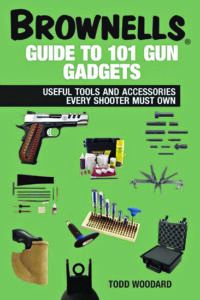
Todd, I want to thank you for all the great info included in the pages of Gun Tests. Being very interested in making my firearms perform better, I was wondering if you and the staff have ever reviewed gun-repair and gunsmithing tools for the beginner? It seems like there are many choices to consider. — Alan
Hey Alan: No, we haven’t. Great idea, so I’ll see who wants to tackle this. Some years ago, I did a book on the topic, the Brownells Guide to 101 Gun Gadgets. It’s available on Amazon.com. — tw

























